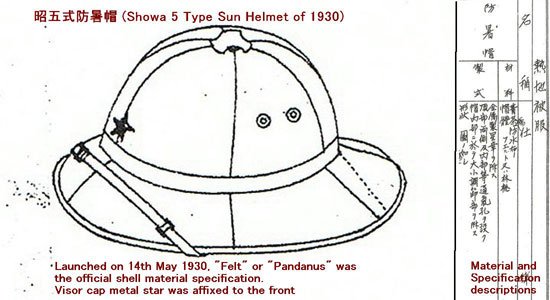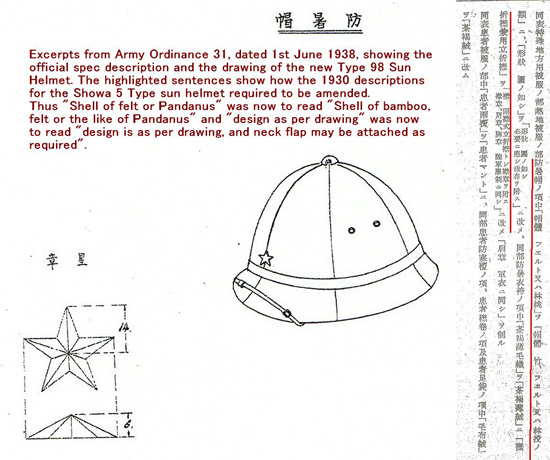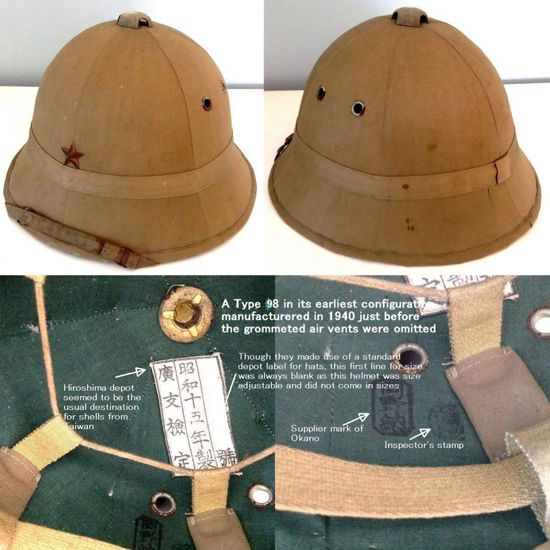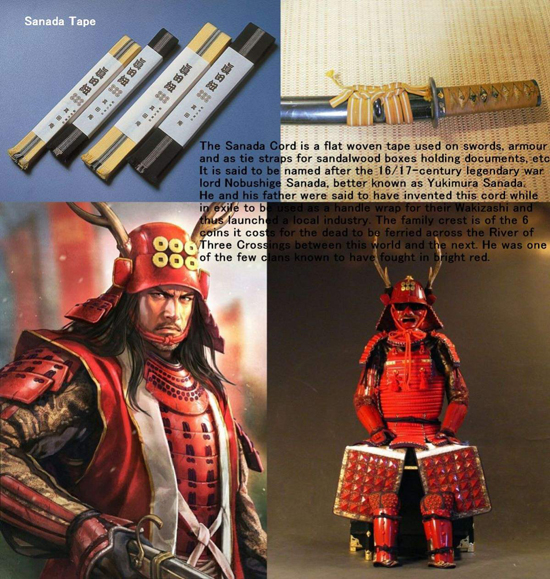This is a special study of Japanese tropical helmets by Nick Komiya, and is presented in four parts.
1930 May, Launch of the Second Model Sun Helmet Showa 5 Type (昭五式)

7 years after the introduction of the IJA’s first sun helmet, a revamp of design was signed off by Emperor Hirohito on 14th May 1930. A whole new range of items got launched at the same time like new canteens, back packs, bread bags and the army jacket now got a vertical seam in the back to rationalize production efficiency.
The external appearance of the sun helmet did not change hugely, but instead of having a third vent grommet on each side, a top vent with cover was revived.
The shell material was now either felt or woven Pandanus (to also include Taiwanese marsh grass). The shell most certainly must have now been reduced to one size as the spec descriptions talk of “internal provision for size adjustments between large and small”. However, the shell shape did not yet conform to the profile of the Type 90 helmet that got launched later that year on 28th October, so the sun helmet did not seem to include wear over the helmet yet.
You may question why I do not simply call it “Type 5”, instead of “Showa 5 Type”. That is simply, because the army itself insisted on calling it the Sho-Go Shiki (“Sho” being abbreviation for the era name of “Showa” and “Go” meaning 5). So “Sho 5 Type” is the direct translation, but that won’t make sense to Westerners, so I used the full word Showa.
1937-1938 Prototype Tests in Taiwan
Once again, after 7 years of using the Type 5 sun helmet, another revamp was in the works. Again a whole lineup of items were to be tested, but the 120 sun helmets shipped from the main depot to reach Taiwan by early June of 1937 aimed at reducing weight and increasing water repellency and sun protection.
Tests were to be conducted again for two summers in 1937/38. The shell material was now a combination of bamboo, cotton wadding and thin balsa sheeting. They seemed also to have tried out the new shell design, shaped like the Type 90 steel helmet already in 1936, but this time improving it further by removing the raised ridge from the edge of the brim to allow rain to flow off more smoothly.
As the new steel helmet profile greatly reduced the size of the rear brim, they also tested a removable 3-section neck flap similar to the 4-section ones used on field caps to be hung at the back of the sun helmet (a much simpler solution than the earlier flip-up rear visor or the samurai armor style collapsible visor suggestion).
1938 June, IJA’s Third Model Sun Helmet Introduced (Type 98 Version 1)

The Type 98 (for the year 2,598=1938) army uniform series was launched on 1st June 1938, and the Spec description for the Showa 5 Type was now changed to have the shell material specs to read “Bamboo, Felt or Pandanus or similar (Taiwanese Marsh Grass)”. Thus material alternatives had increased.
However, in spite of the expanded material choices, the Army in Taiwan still remained responsible for supplying the bulk of the sun helmets, as one can read in a memo dated 28th January 1938, ordering them to supply 110 thousand woven shells to the Hiroshima depot by end of March. This was in addition to the further 40 thousand sun helmets to be completed locally in Taiwan for keeping in stock there.
The new sun helmet design had a profile matching the Type 90 helmet and it was designed so it could be worn alone or also over the steel helmet. When one wore it over the steel helmet, one was supposed to remove the size adjustment cord inside the sun helmet and by running the cord through 3 corded eyelets placed on the inside rim of the sun helmet, it was to be secured to the 3 chin strap fixing-rings inside the steel helmet.

The official description says one could also wear a neck flap on this sun helmet. However, though they had field-tested neck flaps in the previous year’s tests, there is no sign of special flaps for the helmet having been launched, so one can only assume that the flap for the field cap was also expected to be adapted for use on the sun helmet.
Interestingly, the model 98 series also included the army’s first model helmet cover, so it means that two alternative means of preventing the helmet from baking under the sun were offered at the same time, helmet cover or sun helmet. The ventilation grommets and the lidded top vent were carryovers from the Showa 5 Type, but these would gradually be eliminated in the following years, giving a total of three configuration variants of the Type 98 sun helmet by 1942.
1938 Nov.-1939 Nov. Testing of two further alternatives for shell material
Even before the official launch of the Type 98, a memo dated 25th May 1938, already revealed the army’s plan to test out alternative shell material.
Because of the massive mobilizations since the breaking out of the China Incident in 1937, Japan was being faced with severe material shortages of everything and the army had to expand its manufacturing options even if it meant compromising on performance.
This time, among the tropical gear shipped to reach Taiwan by end of June were 75 pieces each of two types of sun helmet prototypes. The troops were to test them again for two summers and report back each November.

” Type A 甲” had a woven bamboo shell which had insulation material sprayed onto it. Artificial leather straps were used for the liner and the two side vents were omitted, leaving only the top vent.
“Type B 乙” on the other hand, had the side vents, but omitted the top vent instead, and the shell material was thin wooden sheets combined with “Sanada” tape with mixed insulation material. “Sanada” referred to a woven tape usually called Sanada Cord, used for straps for armor and swords, an invention stories credit to a famous war lord, Yukimura Sanada (thus the name).
They used this tape material in a spiraling pattern to shape the shell. The result report is missing from the archives for this test, but Sanada tape was definitely added to the spec list and the side vents were omitted from 1941 as you will see soon.

It is most likely that they added another shell variation to be tested in the second summer testing for 1939, as official spec revision history records the addition of chocolate vine as of 6th February 1939.

Can you send me a picture of the the trail helmet that used cotton, balsa sheeting and bamboo if u have one please